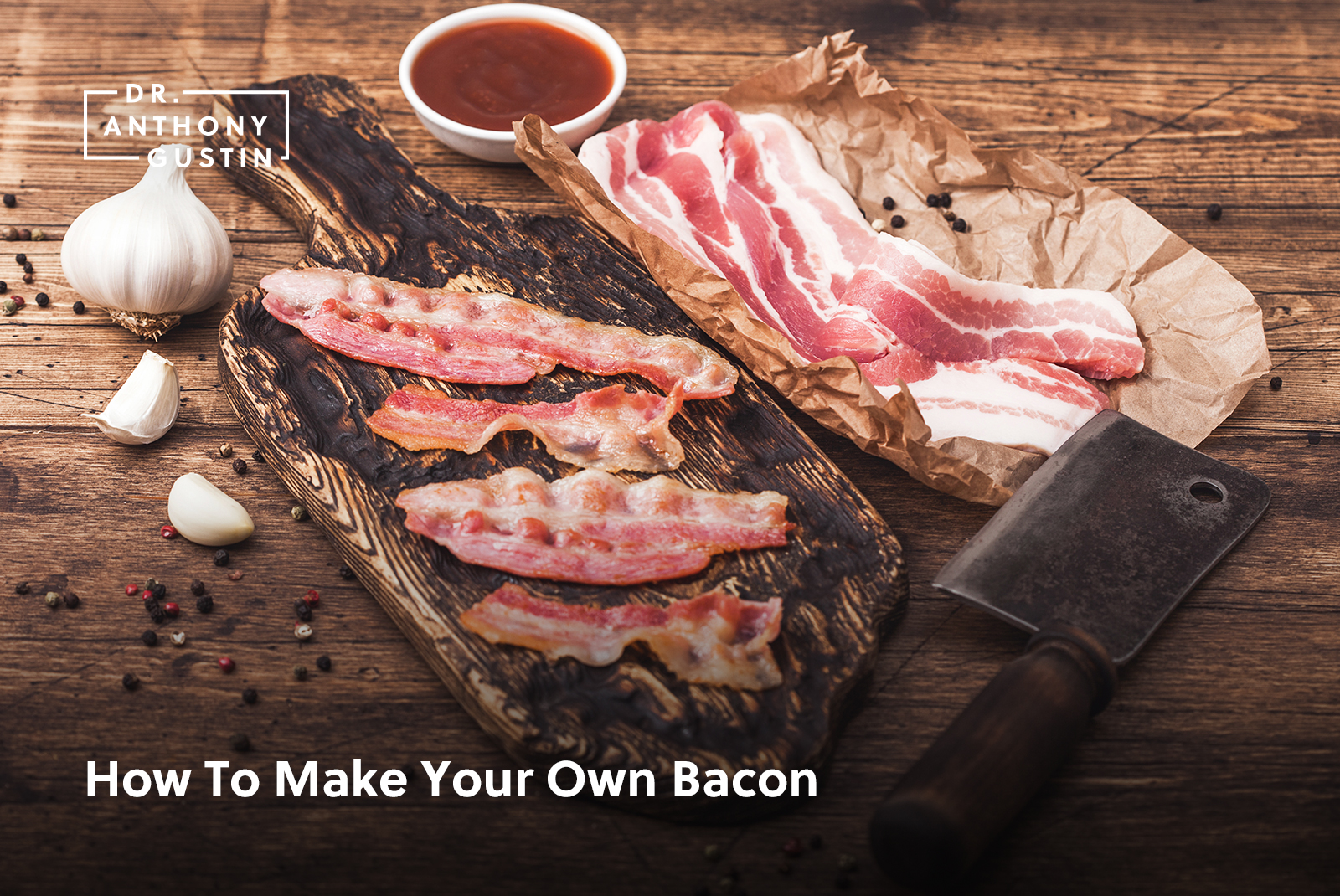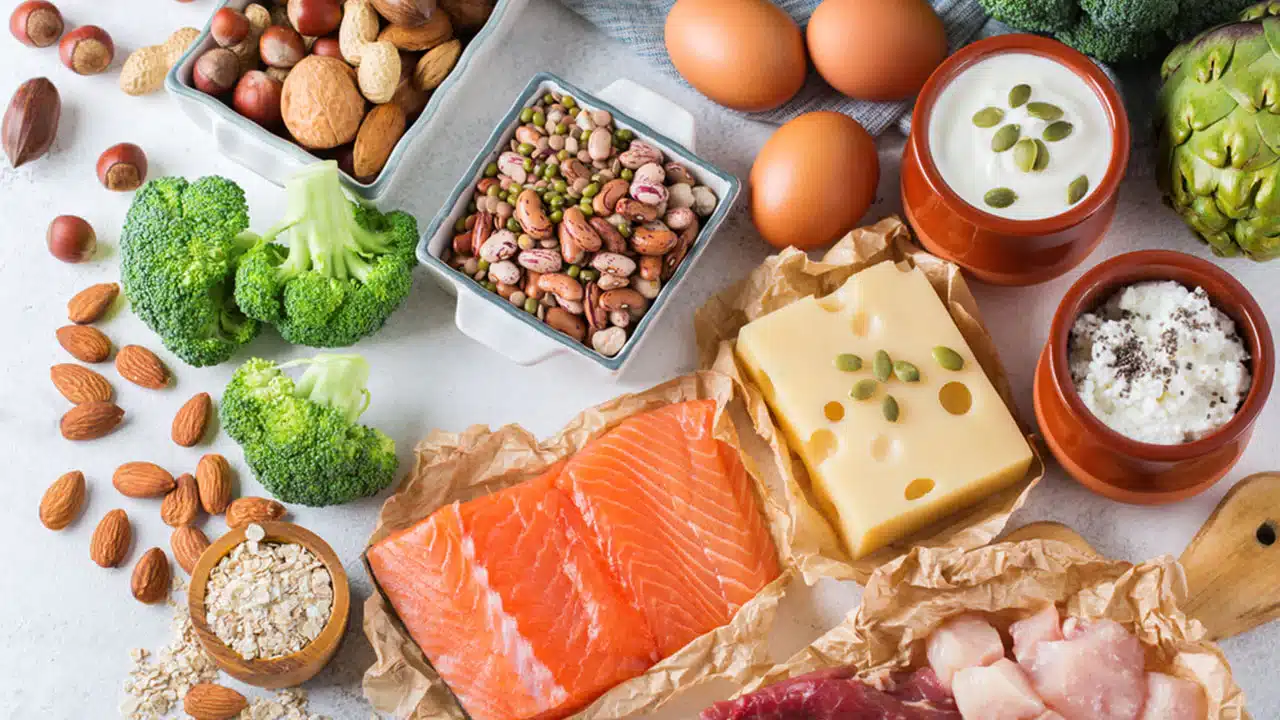How To Make Your Own Bacon

This is going to be a part in our ongoing “How To DIY” section on the website to help you become craftier not only in the kitchen, but the rest of your life as well! We will be launching a new refresh soon with a dedicated section, but for now enjoy the first post on how to make your own bacon.
There is some sort of cult-like affinity for pig parts in general, and bacon especially. Bacon is clearly one of the most trendy foods around (and rightfully so), but there’s a problem. Bacon is expensive, and often not in its ideal form. I’m always trying to find the best quality, best sourced food possible. Unfortunately, it’s hard to find truly pastured (read: more nutritious, less inflammatory) bacon without spending upwards of $20/lb. If you buy commercially produced bacon, it was likely made in some plant thousands of miles away using some odd, high volume manufacturing process. And not that there is anything wrong with unflavored bacon, but once you start experimenting with different flavors, you’ll be hooked. The obvious solution to your sourcing and quality ails is simple: make your own bacon.
It sounds daunting at first, but make your own bacon once and chances are, you’re not going back to any other type of bacon. An added benefit to making your own bacon is the opportunity to experiment with limitless options on the flavor of cure. This is addicting because you can make endless bacon varieties.
Step One: Buy Some Quality Pork Belly
Find some pastured pork belly at a reputable butcher and get a slab. Buy as much as you think you will want. In my experience, this process works best in 1-2 pound portions as the more surface area of the belly you have, the more flavor will penetrate. If you go for more belly, then just have it cut into smaller chunks. Don’t worry about making a lot at a time either, as you can freeze it for a few months. And let’s be serious, you’re going to eat it all before then anyway.
We could chit chat about the importance of sourcing your meat all day, but the facts are simple. Eat animals that ate what they were supposed to. When humans eat junk food, they get sick. Same rules apply to animals. Pigs who are stuffed with grains and junk food all day are going to balloon up and become inflammatory just like most Americans. Source your food properly and you will have much more nutrient dense food and support a more appropriate and ethical way of raising and treating animals.
Step Two: Prepare the Belly
This step is pretty easy. Cut the skin off of the pork belly using a sharp knife. Leave as much fat on the belly as possible when you’re doing this step. This can be pretty tricky if you don’t have a good knife, so if you are close enough with your butcher, just ask them to cut the skin off when you buy it from them.
If you don’t have a good knife, let’s discuss something here quick. You’re trying to make your own bacon, but you don’t have a good knife? What are you waiting for? It is one of the top utensils used for cooking as you should be using it nearly every day. Here are some options for some excellent utility Japanese and German knives.
Don’t throw the skin away! If you’ve sourced your pig properly, you’re going to want to keep this. You can do plenty of things with it, but the most common is just to fry it up and make cracklings with them. Eat nose to tail and don’t throw away the collagen and nutrient rich skin. Search the inter webs for a version that works, or if want, leave a comment below that you’re interested and I’ll post a recipe for you.
Step Three: Cure Belly
Let’s take a moment and chat about about everyone’s unnecessary concern about nitrates and nitrites. There’s a lot of misinformation out there about cured vs uncured and what is healthy and what is not. The truth is, curing meat is not unhealthy and could actually be beneficial towards your health. Also, NOT curing meat could be more dangerous with the possibility of contracting trichinosis from rancid pig parts.
It turns out when we are looking at exposure to nitrites, our body produces far more than we would ever consume in food. 90% of our nitrite exposure actually comes from our own saliva. For food sources, vegetables (especially leafy greens) rank FAR higher than hot dogs, bacon, or ham ever would. Arugula is one of the highest food sources of nitrites. For comparison, one serving of arugula has more nitrites (430mg/100g) than over 400 hot dogs. Yes. 400. Because of some bogus studies that associated nitrites to health problems instead of the insane amount of processing of already sick animals, the government enforces a strict nitrite/nitrate concentration in commercial curing which also limits nitrites and nitrate concentration in meat.
Not only is the nitrite concentration much lower when you cure meats, not much stays around anyway. Nitrites in cures react and turn into nitric oxide and bind to iron. This is what gives bacon, ham and hot dogs their ever popular pink color, actually. Only about 1/10 of the initial, negligible amount of nitrates remain.
Nitrites and nitrates are often demonized for the reason stated above, but studies show that they can actually be beneficial for health. Chris Kresser did some research and found that nitric oxide formed from nitrites have been shown to lower blood pressure and reduce risks of heart attacks. He also found that nitrates have been shown improve the immune system and fight bacteria.
Alright, enough nerding out, back to how you make your own bacon. Here is how we’re going cure it. We’re going to use a curing salt called Prague #1. This salt is 94% regular ol’ salt and 6% sodium nitrite. This is important to kill any bacteria that could lead to nasty and serious conditions from eating rancid pork, like trichinosis. If the sodium nitrite makes you want to not use this, go ahead and reread this entire section and understand that celery has a MUCH higher concentration of nitrites than this curing salt. Are you back? Alright, now let’s talk ratios.
This is a general guideline per one pound of belly. Do the math here and scale if your belly is different from that amount. DO NOT change the amounts and definitely do not decrease the curing salt.
Base:
2 teas. finely crushed sea salt
1/2 teas. Prague #1
½ cup water
What you add after this base is comletely up to you however. If you’re adding in liquid ingredients (coconut aminos, maple syrup, honey, etc) then remove however much quantity of ingredient you adding of water. If you add any more DRY ingredients (paprika, cayenne, black pepper, etc) add that much more of the same quantity of water.
Some examples of home run additions on to the base cure at The Paleo Fix bacon lab include but are not limited to:
Coffee Habanero
3T ground coffee beans
3 finely chopped habanero peppers
Herb and Pepper
2 sprigs rosemary, chopped
2 sprigs thyme, chopped
3T crushed black peppercorns
Sticky Maple
3T (real) maple syrup
1T honey
Thai Surprise
1 ½ T fish sauce
1 ½ T coconut aminos
1 finely chopped green onion
3 finely chopped thai chiles
After you mix your dedicated cure, rub it all over your pork belly and make sure it is covering everywhere in equal amounts. I’m usually not a huge fan of plastic bags, but in this situation they just work the best. Toss the belly into a freezer style bag and squeeze all of the air out and cover the belly in the cure as much as possible. Refrigerate.
Leave the belly in the cure for 6-7 days. Flip it around a few times throughout the process if you have some of the cure settle in the bag. Remove the belly from the bag and rinse the cure off of the belly fully or it is going to be way too salty in the final result. After you pat the belly dry with a towel, we’re ready for the smoker!
If for some reason the cure looks like it has developed a scum, or if it smells funky, TOSS IT. Something went wrong. This is a sign of unwanted bacterial growth and you can get seriously sick from this. Don’t worry though, just follow these directions and everything should work out fine. And be confident! I’ve never had a batch turn bad on me.
Step Four: Smoke the Belly
I know this isn’t going to be entirely accessible for everyone, but if you have space for a smoker and don’t currently have one, I would spring for it. Low and slow is the way to cook meat, and that’s what we’re doing here. You don’t even have to have much space for a smoker. Living in SF does not afford me with much room and I have a mini smoker. I use a Green Mountain Grill. They are versatile and amazing. Highly recommended. I typically use the smallest model and if it is enough to fit two whole spatchcocked chickens on, it is definitely big enough for most tasks. Check out Traeger pellet grills for similar products.
If you don’t want a smoker, no big deal! You can do this part by setting up an indirect heating method with a charcoal or gas grill, combining some wood chips for flavoring. This method is complicated and unreliable, but if you don’t want to invest in a smoker, Google “indirect smoking gas/charcoal grill” and find your solution that way. Others claim this step is also possible in an oven as well. However, I always use my trusty smoker, so don’t blame me if it doesn’t turn out as amazing as I’m describing when you make your own bacon your own way.
On to the smoking part. There are two different ways to smoke bacon. One is cold smoking, which is what is usually done when bacon is processed commercially. This is not what we are going to be doing. There is too much room for error with cold smoking, so we are going to be doing a higher temp that fully cooks the belly, but just enough, to kill off any unwanted bacteria that may still be lurking.
The belly will be smoked at 200 degrees F over indirect heat for roughly 2-3 hours or until the internal temperature reaches 150 degrees F. Use a thermometer and be precise. Be careful to not go over this point however as the belly will start to cook and be rough and chewy when you cook it as bacon in the pan. You want to start to break down the fats but not cook them entirely. Pull that (now) bacon off the smoker when the internal temp reaches 150F and pat yourself on your back, as the bacon is ready to go!
Step Five: Cook the Bacon
I recommend keeping the bacon in large slabs and then cutting with a very sharp knife. If you don’t have said sharp knife (Step One: Buy One) it may be much harder to have consistent slices. You can also chop into little chunks if you like bacon that way. Do you have a nice local butcher? You can also go to them and ask them if they can cut it for you on a commercial grade deli slicer.
Now that it is sliced, cook it up like regular bacon! Low and slow is the way to go again to keep the fats in the healthiest possible way of course. Collect the unused fat from this bacon in a mason jar and use it to fry up eggs, sweet potato fries, or anything else your heart desires.

Enjoy the process, make sure you’re paying attention to all the steps, and HAVE FUN! As a side note, again, if something doesn’t seem right in the process, or if the belly smells funky or looks scummy, TOSS IT. It is not worth the risk of serious illness. Scrap and start over.
Do you do any home bacon prep yourself? Share your techniques or recommendations below and SHARE with anyone who has talked about making their own bacon!
Do you like learning how to take care of yourself from a food and fitness standpoint? Excellent! You can find more awesome resources for taking your movement and physical performance to the next level each week over at The Movement Fix by Dr. Ryan DeBell with Movement Fix Mondays.




